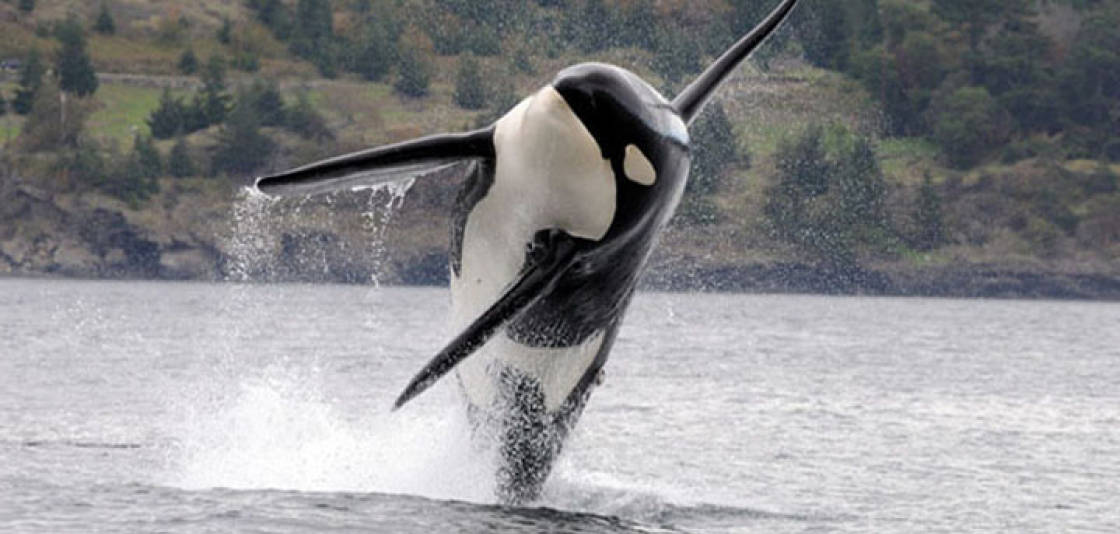By Russel Barsh
Director of KWIAHT
As scientists conducting long-term studies of the marine food web surrounding the San Juan Islands, we are both heartened and disappointed by the recent attention accorded to Salish Sea killer whales; heartened that people care, and disappointed by the kinds of actions that are being promoted.
For a start, it is crucial to distinguish between the three pods that make up the remaining Southern resident killer whale population in the San Juan Islands, and the thousands of orcas that continue to thrive and increase on the Pacific Coast. Southern residents have drawn attention because of their visibility in a heavily-urbanized region of North America, and their economic value to tourism. They have also come to represent a test of our will to “save” biodiversity.
Killer whale conservation is complicated by the fact that these marine mammals evolved into kin groups that differ behaviorally and ordinarily do not interbreed although they are physiologically capable of doing so. Information such as travel routes, and choosing and handling prey appears to be shared by older females with pod mates by demonstration, the way kittens learn from their mothers. As long as behavior continues to be learned, rather than “wired-in” genetically, it can change in response to new conditions. In biology, such alteration is known as plasticity, which is the adaptability of an organism to changes in its environment or differences between its various habitats. Is there evidence of behavioral adaptation by the Southern residents?
The answer is a qualified yes. Southern residents have been spending less of their annual round inside the Salish Sea, shifting their hunting to the much larger year-round streams of salmon migrating along the rim of the Pacific Ocean from California to Siberia. While they prefer Chinook, they are eating some chum and other salmon species that are more abundant in today’s Salish Sea. These adaptive changes appear to be too little and too slow, however. By comparison, the Northern residents of Georgia Strait and the British Columbian coast are not only several times as numerous as our Southern residents but they are increasing, albeit slowly. Northern residents also target Chinook salmon, and seasonally chum salmon as well, and spend part of their yearly round on the Pacific rim. It is also significant that “transient” orcas, which are more highly migratory and prey mainly on smaller marine mammals, appear to be doing well on the Pacific Coast as a whole. Are Northern residents and transients more adaptable than our Southern residents to what is available to eat? Are there other differences in their ecology that deserve our attention?
At the state and local level, the conversation is all about the abundance of Chinook; even to the extreme of arguing about breaching dams on the upper Columbia River watershed, for fish that do not ordinarily venture into the Salish Sea at all. But we need to look deeper into the food web that supports Salish Sea Chinook.
Our research shows that Chinook depend primarily on a diet of herring, Pacific sand lance, also known as sand eels, and for winter resident Blackmouth salmon and shrimp while they are in the Salish Sea. Herring and sand lance depend, in turn, on eating zooplankton — chiefly tiny crustaceans such as copepods and larval crabs. These forage fish and their prey also lay their eggs in marine waters. It should be obvious that the abundance of Salish Sea Chinook must depend, in large part, on the level of toxic pollution in our waters, and that any increase in hatchery production or decrease in harvesting will be mediated by the impact of pollution on the health of salmon, and on the health and abundance of zooplankton, herring and sand lance.
Millions of people live and work along the shores of the Salish Sea, and we are far from eliminating new toxic discharges, not to mention sequestering legacy contaminants from the last century. Tiny marine organisms can be highly sensitive to regionally pervasive contaminants such as pesticides, PAHs, copper and detergents. If they survive exposure to toxics they may pass them along to predators such as fish and marine mammals.
It’s a lot easier to cut back on salmon dinners and whale-watching, than to clean up toxic discharges from several million people, their homes and businesses. Here in San Juan County, we do not yet even have state-compliant storm water treatment for our growing towns. While more Chinook salmon and less marine noise and disturbance could be good for Southern residents and other Salish Sea marine mammals and fish, what makes the Salish Sea ecosystem as a whole highly vulnerable is the concentration of contaminants in a relatively shallow, urbanized, industrialized water body.
If Southern residents are dying off slowly from our toxic waste, quieter waters and a little more fish to eat will likely only delay their demise, and do little for the marine ecosystem as a whole. In our haste to win the battle for survival of a small group of killer whales, we are at risk of losing the real war for the future of the Salish Sea.
Kwiaht is a science laboratory based out of Lopez Island.



